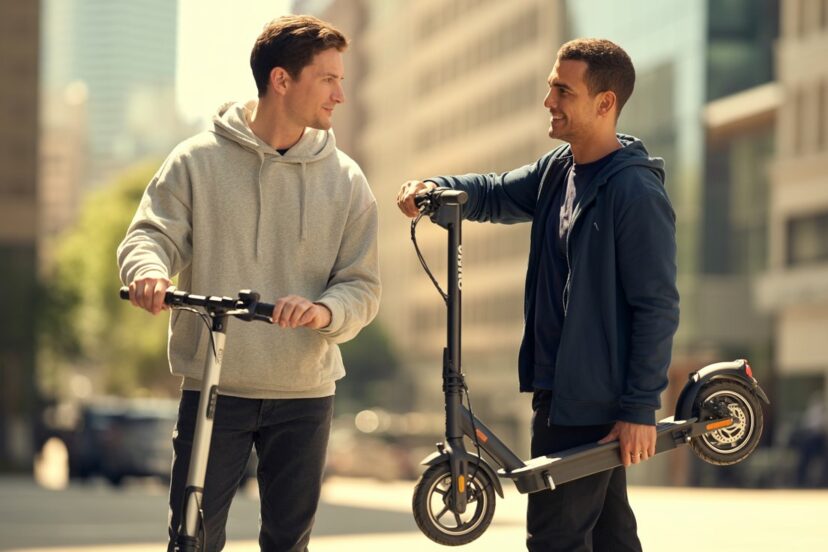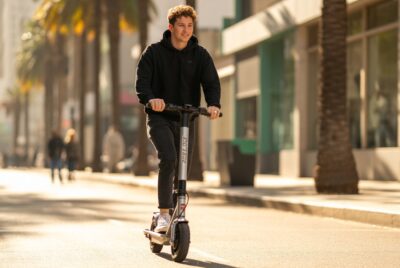Folding vs. Non-Folding Electric Scooters: The Ultimate Guide
*We may earn a commission for purchases made using our links. Please see our disclosure to learn more.
The electric scooter market has exploded in recent years, transforming how people navigate urban environments and short-distance travel. Standing in the aisle of an electronics store or scrolling through countless online options, many riders find themselves facing a crucial decision: should they invest in a folding electric scooter or stick with a traditional non-folding model?
This choice isn’t just about convenience—it’s about lifestyle, storage constraints, commuting needs, and long-term satisfaction with your investment. The folding mechanism might seem like a simple feature, but it fundamentally changes how you interact with your scooter on a daily basis.
“The portability factor of folding electric scooters has revolutionized urban mobility, making it possible for commuters to seamlessly transition between riding and carrying their transportation device.”
– Urban Mobility Research Institute
Key Takeaways
Before diving deep into the comparison, here are the essential points to remember:
- Folding scooters excel in portability and storage but may sacrifice some structural integrity
- Non-folding models typically offer superior durability and performance with fewer mechanical failure points
- Your commute style and storage situation should be the primary factors in your decision
- Weight capacity and rider comfort often favor non-folding designs
- Budget considerations vary significantly between the two categories
- Maintenance requirements differ based on the complexity of folding mechanisms
Top Electric Scooter Recommendations
Best Folding Electric Scooters
Hiboy S2/S2 Pro/S2 MAX Folding Electric Scooter
The Hiboy S2 Series (S2, S2 Pro, and S2 MAX) offers a solid example of a folding electric scooter built for adult commuters. Powered by a 350W–500W brushless motor, it delivers a top speed of up to 19 mph and a maximum range of up to 40.4 miles (depending on the model). Its 10-inch solid tires and rear dual shock absorbers provide smooth rides even on bumpy roads. The scooter folds easily, making it ideal for carrying on public transport or storing in compact spaces.
When comparing folding vs. non-folding electric scooters, the Hiboy S2 Pro clearly shines in portability, smart features, and commuter convenience. Non-folding scooters may offer more rugged performance or larger builds for long-range travel, but they sacrifice flexibility. For riders in cities or those with limited storage space, a folding model like the Hiboy S2 Pro gives you the power of a high-performing scooter without the bulk — and it tucks neatly into a trunk or under a desk.
- Portability: Folds down quickly for storage or transit, perfect for city commuters.
- Ride Comfort: Dual shock absorption and large solid tires make daily rides smoother.
- Smart Features: App connectivity lets users control acceleration, braking, and locking.
- Weight: At 35.9 lbs, it’s a bit heavy to carry for long periods.
- Not Ideal for Off-Road: Solid tires offer comfort but aren’t built for trails.
- Seat Sold Separately: Seat option adds comfort, but it’s not included by default.
Best Non-Folding Electric Scooters
Gyroor C1S Electric Scooter
The Gyroor C1S Electric Scooter is a folding commuter scooter designed for adults who need extra cargo space. Equipped with a 550W motor, it delivers speeds of up to 18.6 mph and a range of 15–20 miles per charge. What sets it apart is its large center basket, rear cargo rack, and a wide 9.5” deck that can accommodate a small pet or bags — ideal for errands, delivery, or travel with gear.
When exploring the folding vs. non-folding electric scooter debate, the Gyroor C1S blurs the lines. While technically a folding scooter, its larger frame, cargo baskets, and wide deck give it the functionality of a non-folding utility scooter. It’s ideal for users who prioritize practicality — like running errands, commuting with gear, or traveling with a pet.
- Cargo Capacity: Comes with two baskets and a wide deck—perfect for groceries, bags, or even a small pet.
- Comfort & Stability: 12" thick rubber tires and seat offer a smoother ride over bumps.
- Adjustable Design: Seat and frame suit a wide range of adult riders from 5'1" to 6'1".
- Heavier Build: Due to added baskets and size, it’s bulkier than typical folding scooters.
- Lower Range: 15–20 miles may not suit long-distance commuters.
- Bulky Fold: Though foldable, it may be harder to carry compared to more compact models.
Understanding the Fundamental Differences
The Folding Revolution
Folding electric scooters represent innovation in urban mobility. The ability to collapse a scooter into a compact form factor addresses one of the biggest challenges facing electric scooter adoption: storage and portability. When you can fold your scooter and carry it onto public transportation, into your office, or up several flights of stairs, it transforms from a sometimes-convenient vehicle into a truly versatile transportation tool.
The engineering behind folding mechanisms has evolved significantly. Modern folding systems use robust hinges, quick-release levers, and reinforced connection points that aim to maintain structural integrity while providing convenience. However, every folding joint represents a potential point of wear and mechanical failure.
The Stability of Fixed Frames
Non-folding electric scooters prioritize structural integrity above all else. Without the need to accommodate folding mechanisms, engineers can focus on creating the most robust, stable platform possible. These scooters typically feature continuous frame construction, which distributes weight and stress more evenly throughout the structure.
This approach often results in higher weight capacities, better handling characteristics, and longer overall lifespan. The trade-off is obvious: reduced portability and increased storage requirements.
Portability and Storage Considerations
Urban Living Challenges
City dwellers face unique storage constraints that significantly impact scooter choice. Apartment living often means limited storage space, narrow hallways, and the need to carry items up multiple flights of stairs. Folding scooters address these challenges directly by reducing their footprint when not in use.
The typical folding scooter can be stored under a desk, in a closet corner, or even carried onto public transportation during peak hours. This flexibility makes them particularly appealing for commuters who need to combine scooter riding with other forms of transportation.
Suburban and Rural Considerations
Riders in suburban or rural areas often have different priorities. With garage storage available and less need for public transportation integration, the portability benefits of folding scooters may be less critical. These riders might prioritize performance, comfort, and durability over compactness.
Performance and Durability Analysis
Structural Integrity Comparison
The fundamental engineering difference between folding and non-folding scooters lies in their approach to structural loads. Non-folding scooters can utilize continuous frame members, which provide superior strength-to-weight ratios and more predictable stress distribution.
Folding mechanisms, regardless of their quality, introduce complexity and potential failure points. The hinge areas must withstand repeated stress cycles while maintaining tight tolerances for safe operation. Over time, these mechanisms may develop play or looseness that affects ride quality and safety.
Performance Characteristics
Non-folding electric scooters often excel in several performance metrics. The rigid frame construction typically provides better handling characteristics, especially at higher speeds or when navigating uneven terrain. The lack of folding joints can also result in improved power transfer from the motor to the wheels.
Folding scooters have made significant strides in performance, but physics still imposes limitations. The need to accommodate folding mechanisms often results in compromises in frame geometry, weight distribution, or component placement.
Weight and Size Considerations
Transportation Implications
The weight difference between folding and non-folding scooters extends beyond the folding mechanism itself. Folding models often incorporate lightweight materials and components to maintain portability, while non-folding versions can utilize heavier, more durable materials without the same portability concerns.
This weight difference becomes critical when considering how often you’ll need to carry or lift your scooter. A difference of even five to ten pounds can significantly impact the practical usability of a folding scooter for commuters who need to carry it regularly.
Storage Space Requirements
The storage footprint difference between folded and non-folded scooters is dramatic. A typical non-folding scooter might require 4-6 square feet of floor space, while the same scooter in folding form might need less than 2 square feet. This difference can determine whether scooter ownership is feasible in cramped living situations.
Cost Analysis and Value Proposition
Initial Investment Considerations
The pricing landscape for electric scooters reveals interesting patterns when comparing folding versus non-folding models. Entry-level folding scooters often command premium prices due to the additional engineering and manufacturing complexity required for reliable folding mechanisms.
Conversely, non-folding scooters can sometimes offer better performance per dollar spent, as manufacturers can focus their engineering efforts on power, range, and durability rather than portability features.
Long-term Ownership Costs
Maintenance costs present another important consideration. Folding mechanisms require periodic inspection and maintenance to ensure safe operation. The additional moving parts can also contribute to higher long-term maintenance costs compared to the simpler construction of non-folding models.
However, the convenience factor of folding scooters may lead to increased usage, potentially providing better value through more frequent use and transportation cost savings.
Maintenance and Longevity Factors
Mechanical Complexity
The folding mechanism represents the most significant maintenance difference between the two scooter types. These systems require regular inspection for proper operation, wear, and secure locking. The hinges, levers, and locking mechanisms need periodic lubrication and adjustment to maintain smooth operation and safety.
Non-folding scooters eliminate these maintenance requirements entirely, focusing maintenance efforts on the motor, battery, tires, and brakes—components that both types share.
Component Accessibility
Interestingly, folding scooters sometimes offer better access to internal components for maintenance and repair. The ability to fold the scooter can provide easier access to wiring, battery compartments, and other serviceable parts. Non-folding models may require more extensive disassembly for similar maintenance tasks.
Making the Right Choice for Your Lifestyle
Commuter Profiles
Different commuting patterns strongly favor one scooter type over the other. The daily urban commuter who combines scooter riding with public transportation, navigates crowded sidewalks, and stores their scooter in small office spaces will likely benefit significantly from folding capability.
Suburban commuters with consistent point-to-point travel, dedicated storage areas, and longer daily distances might find non-folding models more suitable for their needs.
Usage Pattern Analysis
Consider how your scooter usage patterns align with each design’s strengths. Frequent short trips with multiple stops favor folding models, while longer rides with fewer interruptions might be better served by the stability and comfort of non-folding designs.
Future Needs Assessment
Electric scooter purchases represent long-term investments, so consider how your needs might evolve. Career changes, housing situations, and lifestyle modifications can all impact which scooter type will serve you better over several years of ownership.
Safety and Reliability Considerations
Structural Safety Factors
The safety implications of folding versus non-folding designs extend beyond simple mechanical reliability. The additional complexity of folding mechanisms introduces potential failure modes that don’t exist in fixed-frame designs. While modern folding systems incorporate multiple safety features and redundancies, they still represent additional points of concern.
Regular inspection of folding mechanisms becomes a critical safety practice, requiring users to check for proper locking engagement, wear on moving parts, and overall structural integrity before each ride.
Ride Stability and Control
Non-folding scooters typically offer superior ride stability due to their continuous frame construction. This stability translates to better control, especially at higher speeds or when navigating challenging terrain. The rigid connection between front and rear sections provides more predictable handling characteristics.
Folding scooters have improved significantly in this area, but the inherent flexibility in their folding joints can still result in less precise handling compared to their non-folding counterparts.
Environmental and Practical Considerations
Urban Infrastructure Integration
The choice between folding and non-folding scooters often depends on how well they integrate with existing urban infrastructure. Folding scooters excel in mixed-mode transportation scenarios, allowing seamless transitions between scooter riding and other transportation methods.
Cities with comprehensive public transportation systems, bike lanes, and scooter-friendly policies often favor folding models due to their versatility and reduced storage burden on public spaces.
Weather Protection and Storage
Weather considerations affect both scooter types, but storage flexibility gives folding models an advantage. The ability to quickly bring a folding scooter indoors protects it from rain, snow, and temperature extremes that can affect battery life and component longevity.
Non-folding scooters often require dedicated outdoor storage solutions, which may expose them to weather-related wear and potential security issues.
The Technology Evolution
Battery and Motor Integration
Both folding and non-folding electric scooters continue to benefit from advances in battery technology and motor efficiency. However, the space constraints of folding designs sometimes limit battery capacity or require compromises in component placement.
Non-folding scooters can more easily accommodate larger batteries and more powerful motors without the geometric constraints imposed by folding mechanisms.
Smart Features and Connectivity
Modern electric scooters increasingly incorporate smart features like app connectivity, GPS tracking, and theft protection. These features can be implemented in both folding and non-folding designs, though the additional complexity may be easier to accommodate in non-folding platforms with more available internal space.
Cultural and Social Considerations
Public Perception and Acceptance
The social aspects of electric scooter ownership vary by region and local culture. Folding scooters often appear more professional and less intrusive in office environments, while non-folding models might be perceived as more serious transportation devices.
Understanding your local community’s attitudes toward electric scooters can influence which type will provide the best ownership experience.
Community and Usage Patterns
Different scooter types often attract different user communities. Folding scooter users frequently prioritize convenience and urban mobility, while non-folding enthusiasts might focus more on performance and recreational riding.
These community differences can affect available support, maintenance resources, and shared knowledge about optimal usage practices.
Conclusion
The choice between folding and non-folding electric scooters ultimately depends on individual priorities, lifestyle requirements, and intended usage patterns. Folding scooters excel in urban environments where portability, storage flexibility, and multi-modal transportation integration are paramount. They offer unmatched convenience for commuters who need to carry their scooters regularly or store them in small spaces.
Non-folding electric scooters provide superior structural integrity, potentially better performance, and often represent better value for riders who prioritize durability and don’t require portable storage. They’re ideal for consistent point-to-point transportation where the scooter can remain in vehicle form throughout its use cycle.
The electric scooter market continues to evolve, with improvements in both categories addressing their respective limitations. Folding mechanisms are becoming more reliable and durable, while non-folding models are incorporating better portability features where possible.
Consider your daily routine, storage constraints, transportation needs, and budget when making this decision. The right choice is the one that seamlessly integrates into your lifestyle and provides reliable, enjoyable transportation for years to come. Whether you choose the convenience of folding capability or the robust simplicity of a fixed frame, electric scooters offer an environmentally friendly, cost-effective solution to modern transportation challenges.
Frequently Asked Questions
Q1: How much weight difference is there between folding and non-folding electric scooters?
The weight difference typically ranges from 2-8 pounds, with folding scooters often being lighter due to the need for portability. However, the folding mechanism itself can add weight, so the difference depends on the specific models and materials used. Most folding scooters weigh between 20-35 pounds, while non-folding models range from 25-45 pounds.
Q2: Are folding electric scooters less durable than non-folding ones?
Generally, yes. Folding mechanisms introduce additional moving parts and potential failure points. However, high-quality folding scooters can still provide years of reliable service with proper maintenance. The key is choosing reputable brands and regularly inspecting the folding components for wear or looseness.
Q3: Can I take a folding electric scooter on public transportation?
Most public transportation systems allow folding electric scooters, especially when folded, but policies vary by location and transit authority. Always check local regulations before traveling. Many systems treat folded electric scooters similarly to large luggage or bicycles.
Q4: How often do I need to maintain the folding mechanism?
Inspect the folding mechanism before each use for proper locking and security. Perform more detailed maintenance monthly, including cleaning and lubricating hinges and checking for wear. Replace worn components immediately to maintain safety.
Q5: Which type is better for longer commutes?
Non-folding electric scooters typically perform better on longer commutes due to their superior stability, comfort, and often larger batteries. However, if your longer commute involves carrying the scooter or combining it with other transportation methods, a high-quality folding model might be worth the performance trade-offs.










